
PRODUCERS:- SETTING UP YOUR BUSINESS |
 < PRODUCERS:- SETTING UP YOUR BUSINESS
< PRODUCERS:- SETTING UP YOUR BUSINESS
You may have a product that you think 'customers' will want to buy. The next step is to test your idea in practice and to determine if and how you can make it grow. Just like any other start up business, you need to think about:-
Your local Farmers Market ! .
Farmers Markets are basically specialist ‘pop-up’ food outlets. They already attract shoppers who are want to purchase good quality, locally produced, food and drink (i.e. your type of customer). The Markets are a low cost investment compared to renting your own shop or selling via a 3rd party (wholesaler). Furthermore selling at these locations will enable you to determine how your product will be received, their price and what you may need to change to make it more attractive.
If you are planning to sell food produce, made, grown or bred by yourself you will still have to conform to the same regulations as you would if you were selling from your own retail outlet.
You will need to have :-
a) Stallholder insurance A basic insurance will cover your stall at any market for Product, Public and Employee liability. Stallholder Insurance
A more comprehensive insurance will combine the insurance of the location where you produce your products with stall insurance. Again G.M. Imber can help.
b) Local Authority Environment Dept approval. You must apply for this if you are cooking on your premises. Your Local Authority will then inspect your premises and give it a rating in terms of ‘Scores on the doors’. (A score of 3 is the lowest acceptable in order to sell at a Farmers Market).
See Appendix E 'Scores on the Doors'
You should first ask yourself:-
Something which is different and which customers cannot buy at supermarkets.
Look around at other markets and see what’s already on offer and selling well
Pricing is important – it must reflect costs of production and not be too cheap, but it must also not be too expensive, especially if a similar produce is already available.
Customers care about quality and provenance more than ever before – they want to know where their food comes from and they support local. In particular they want 'value for money'
As a one to two person business do you have sufficient time to produce a wide variety of products. You should create a priority list in terms of time spent, profit made and demand to determine on what to concentrate.
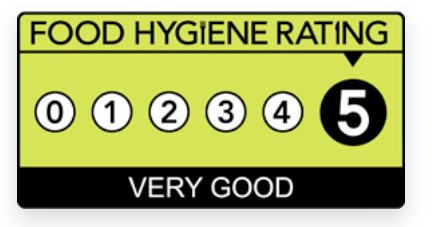
Note your card reader will have to work on all the sites you attend so a 4G version may be essential
KFMA have a Supplier's catalogue which can offer you good value for money. When you join as a KFMA Member you will be able to get a discount or cash back. Click here to see the Catalogue
Having worked out a price per item you now need to determine how many items (x price) you need to sell to cover your production and marketing costs to make a rewarding profit. You will have to juggle with the numbers a few times to turn them into a realistic statement.
Having now done some research and created an initial Cash Flow write it down. Your Business Plan simply brings together all your ideas and processes sector by sector.
The main sectors are
A Business Plan is a vital document for you to work out and state your strategy for growth. It should also make you think about what happens if there are major changes outside of your control (e.g. the general economy), if finance is not available.
A Business Plan is essential if you want to borrow funds for advancing the business.
A 'brand' enables customers to immediately recognise what your business stands for. In our case the brand is based on the words 'Farmers Market' and our logo.
This is what differentiates Farmers Markets from other food retail outlets and gives them their unique 'brand'. Shoppers attending Farmers Markets also understand this concept and will expect you to conform to it. Brands have an easily recognosed logo. In our case this is our logo. As a KFMA member you use this logo.
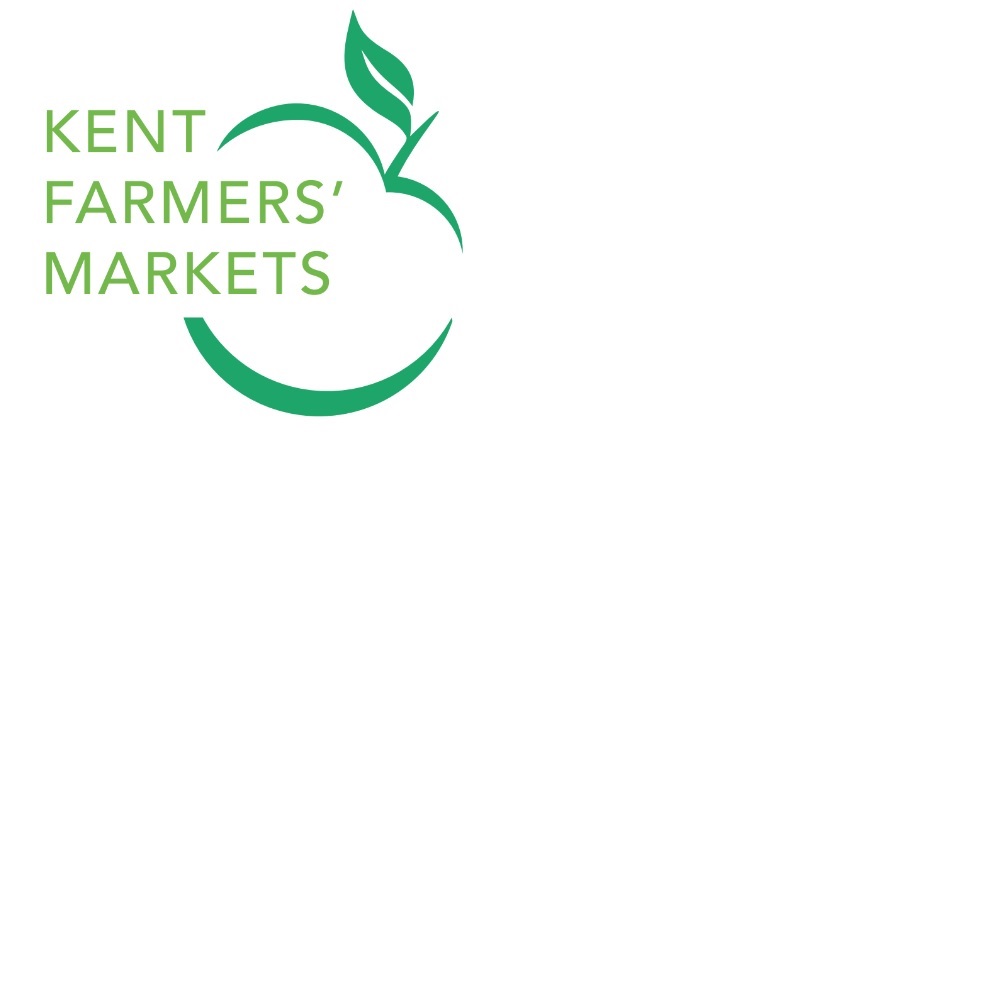
If you have products you have grown, raised, brewed or crafted yourself you can sell it at a Farmers Market. However, the Farmers Market brand requires you to:-
These rules also form the basis of Farmers Market USPs (Unique Selling Points') and defines our THE BRAND.
This is what makes Farmers Markets different from other food retail outlets and what attracts shoppers.
Markets may permit certain exceptions to these rules for produce that are not available locally (e.g. fish). These stallholders are defined as 'Guests'. In order to ensure the shopping public do not misunderstand of what is sold on the Market we recommended that they call themselves 'Farmers and Craft Markets' ,'Village' or 'Community' Markets. They follow the above rules for selling food products but in addition allow stalls selling locally made craft products to sell at their markets.
The cost of trading at Farmers Markets is low which means that they offer the perfect way to test the viability of your business ideas. It avoids the need of you having to invest in your own shop or sell to a third party, who takes part of your margin (i.e. the wholesaler). Farmers Markets are in effect 'incubators' for small food entrepreneurs.
Getting into a Farmers’ Market can be competitive. There are over 400 Food Producers that wish to sell our Farmers’ Markets. Managers want to attract Producers who can offer variety to their market as they want to attract more shoppers. Smaller markets may not have the space or sufficient customers to duplicate stalls, but larger markets may have multiple stalls selling similar products. Market Managers need to ensure that all Producers make a decent return when attending their market, so if your application is rejected the reason often is not because of a failure on your part.
The University of Kent reviewed the 'business model' of Farmers Markets in 2004 They recommended that we should create a network to promote all Farmers Markets and to offer Advice and Guidance to both Managers and Producers alike. With all members of the network investing a small annual fee it meant that the Association could afford to hire skills to work on projects.
These are still the main objectives of the Association plus we have added the need to promote Producers .
The first and still the most important project carried out by the Association was to create a 'one stop shop web site' to promote Markets and now Producers. The main function is to help potential customers to find Markets, when they are held and where to park but also to promote special events, Producers who attend that market and to offer Advice and Guidance to both Managers and Producers alike.
We are continually expanding the web site and Advice and Guidance sections. Please contact us at info@kfma.org.uk if you have any ideas to improve it.
Our latest project is the 'EatDrinkKent' magazine which is aimed at attracting new customers with articles on where to find local produce, the Producers, 'how to cook' produce, Recipes and health aspects of buying fresh food. We will give you, the Producers, a copies of the magazine so you have a quality product to give to your customers with the request that they give a copy to their friends
Kent Farmers Market Association's (www. kfma.org.uk) web site is a 'One Stop Shop' for customers to find out all about Markets and Producers but also it is used by Market Managers and Producers as a reference point for Advice and Guidance.
As a Producer Member the web site provides you with your own web page and images. This avoids you having to design and pay for the design of your own site, it removes the problem and time of implementing your own web site but most importantly gives you immediate exposure to the thousands of readers who look at the KFMA web site (last year 88000 readers used the web site). Over the years the web site www.kfma.org.uk is looked at by over 5000 viewers every month (which peaked to 8000 during lock down as potential customers looked to see what markets were open).
See KFMA WEB site Section for more detail.
Your web page template comprises:-
Last year over 80,000 viewers used the web site.
The Association produced a Members Handbook to explain how by working together we can all help each other and all progress which defines all the benefits of Membership features see 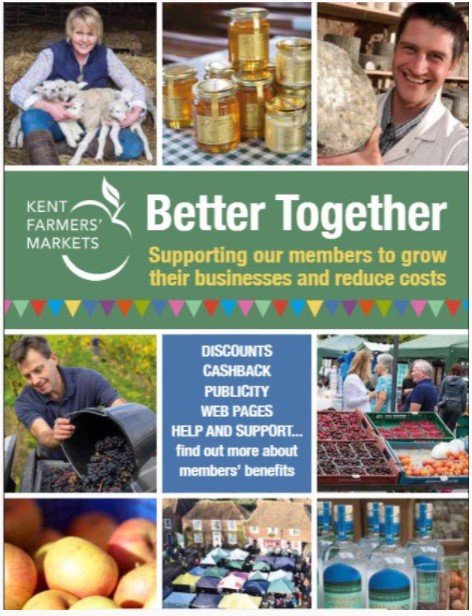
A separate section of the web site is reserved for Members to promote your business via our twitter feed. Contact Steve@kfma,org,uk
Members are the first to be informed about new markets and special events, new legislation etc). Members always come first in the Stallholder Market listing and Listings of Stallholders looking for Markets.
We are always looking for new ideas that would benefit others. Please let us know what is missing or could be improved by sending details to bob@kfma.org.uk).
KFMA have discount agreements with various suppliers. Click here to see Suppliers Catalogue
KFMA is a subscription 'Not for profit' organisation. We use your funds to both promote and support Members.
The cost of a Producer Member is £55 (you can also pay by direct debit). If you also take out the Stallholder Insurance we discount the your Membership fee by £5
Please contact our membership Secretary laura@kfma.org.uk to organise payments and to set up your web site.
We are a Board of volunteers and we rely on your skills and support to help us maintain both the web site and other programmes going forward.
We are keen to support ideas to promote our members and Association and to fund projects which offer benefit to many.
If you are keen to help and support us in any way please contact bob@kfma.org.uk.
See MEMBERSHIP for details. Complete our basic input form (Appendix A2) and email to Laura@kfma.org.uk. This is sufficient for Laura to set up your web page. Send pictures of your stall, farm and products etc to Laura separately (make sure to refence your Trading name).
Your web page defines the 'static' information about your business i.e. your background, your products. It also highlights where you sell your produce i.e. all the markets, whether you offer an on line service. Your Social media sites should concentrate on NEWS, e.g. what will have on your next market stall, what is in season, use pictures to create tour story on Facebook, Instagram etc sites so again by linking from your web page have a far better chance of readers linking to these sites.
Please discuss setting up your own social media sites with Laura@kfma.org.uk
We are in the process of creating a seasonal magazine devoted to local food (see Eat Drink Kent) which is all about informing customers as to what you can buy, where to buy it, how to cook it, how to store it and highlights Producer Members. The magazine and web site are now both aimed to highlight seasonal food, who grows/makes the produce, recipes and healthy food.
This is a great opportunity for you to promote your business. Please contact our editor Bruce with a draft of your story (mcmichael@clara.co.uk)
See the listing which is available to all Market Managers of ‘Producers looking for Markets’. An automatic email will be sent every 2 months whether you wish to update the ‘Markets looking for Stallholders’ listing. In addition, laura@kfma.org.uk can send urgent request information via our internal newsletter to all Market Managers.
This is designed for selling at markets (to insure your food business i.e. prep area etc please contact G M Imber our agent, directly). This package provides Product, Employee and Public liability whilst at the market. All stallholders MUST have such insurance before selling at a market See Section 10.1 Insurance
KFMA have discount agreements with various suppliers. Click here to see Suppliers Catalogue
Every month Kent Farmers’ Markets sends an email out with the latest requests from Markets looking for Stallholders and Stallholders looking for Markets. Send you request to laura@kfma.org.uk to be included in the newsletter
The information on the listing is limited by time as after 6 weeks stallholder information will drop off (to avoid the information being on the listing for a long period). You will need to request Laura to add yourself on again after the time period lapses.
This listing is available to Market Managers and Stallholders. Stallholder information will disappear after 4 weeks. You will need to request it continue for another 4 weeks
The web site also includes a lot of basic information which can help you and avoid a lot of wasted investigative time.
We will still list you on the pages of the markets you attend. This includes a 2 line description only (no images) though it will include your Hygiene rating ('Scores on the Doors'). Please contact our membership Secretary laura@kfma.org.uk tto add your details onto the web site and to upgrade to full membership.
We will always send you information which will benefit your business. However, all such communication is prioritised and Non members receive this information after Members.
When you sell food to the public it is essential that you understand your responsibilities and take reasonable precautions to ensure that you conform to the the appropriate Trading Standards governing the type of food you are selling. Labelling of pre-packed food is especially important i.e. you need to determine the 'Use by' period and apply appropriate dates to all labels. (See Appendix E for specific information)
KCC Trading Standards now offer you a free 30 minute phone consultation regarding specific advice and guidance for your business (the consultation becomes chargeable after 30 minutes). Click Click here for detailed information. Trading Standards Business Advice Team can be contacted for advice on a range of different subject, including food labelling. Their email address is TSbusinessadvice@kent.gov.uk
Contact details are:-Trading Standards Environment, Planning & Enforcement | Kent County Council | PO BOX 320, Ashford, TN24 8AS | Tel: 03000 413887
See web site www.kent.gov.uk/tradingstandards
There are also a range of guidance notes published through their KCC Business Companion website where you will find basic, concise and detailed guidance documents on this website which cover a range of topics, including:-
You are responsible for ensuring public safety e.g. health and hugein standards are followed, members of the public cann otrip over anything belonging to you, your gazebo MUST be made safe from the weather (sudden gusts of wind may get under a gazebo and toss it over). Before you can trade at a market you must have Stallholder insurance which protects your Business and the public. You will need Public and Product liability insurance (min £5 million cover) plus Employees insurance (which includes volunteers) to protect anyone manning your stall. KFMA co-operates with G M Imber Ltd. which has a cost effective Stallholder insurance package (one for food and another for craft).
To print their form (Click here). Complete the form and mail back or take a photo and email back. To review their Terms and Conditions Click here
Always review insurance policies so you are familiar with the terms especially
This is a special insurance covering you when you attend any market. If you also require insurance to cover your business we have also found G M Imber offers good value for money, however you will have to contact them directly to discuss your requirements in detail.
In all cases make sure you undertsand the excess clauses in your policy, as a general rule the cheaper the policy the higher the excess !!
You must by law define any allergens in your products. See Appendix F re definition of Allergens which should be noted on your product label nd Appendix G re an Allergen Chart which you should have available on request by a Customer
If you have any appliances which use electricity on your premises and or stall they, and their connections, must be regularly checked by an approved PAT inspector.
From 21st May 2021 all businesses regardless of size are required by law to charge a minimum of 10p for every single-use carrier bag.
These bags are defined as :-
You don’t charge for plastic bags that are:
For every bag that you charge for, you must charge at least 10p a bag
As a small business you are not required by law to record and report how many bags you sell but it is expected that you give the money made to charities (preferably environmental charities)
It can be very daunting going to your first market. What is commonplace to all the other Producers is something totally new to you. Stallholders are a friendly lot and will be very helpful. However there is such a lot to remember as well and making/cooking/growing your products we have produced a checklist for you Click here to see the Check list. We recommend you print it out and tick everything off as you pack your car/van/truck !
To set up a basic web site please complete the attached form 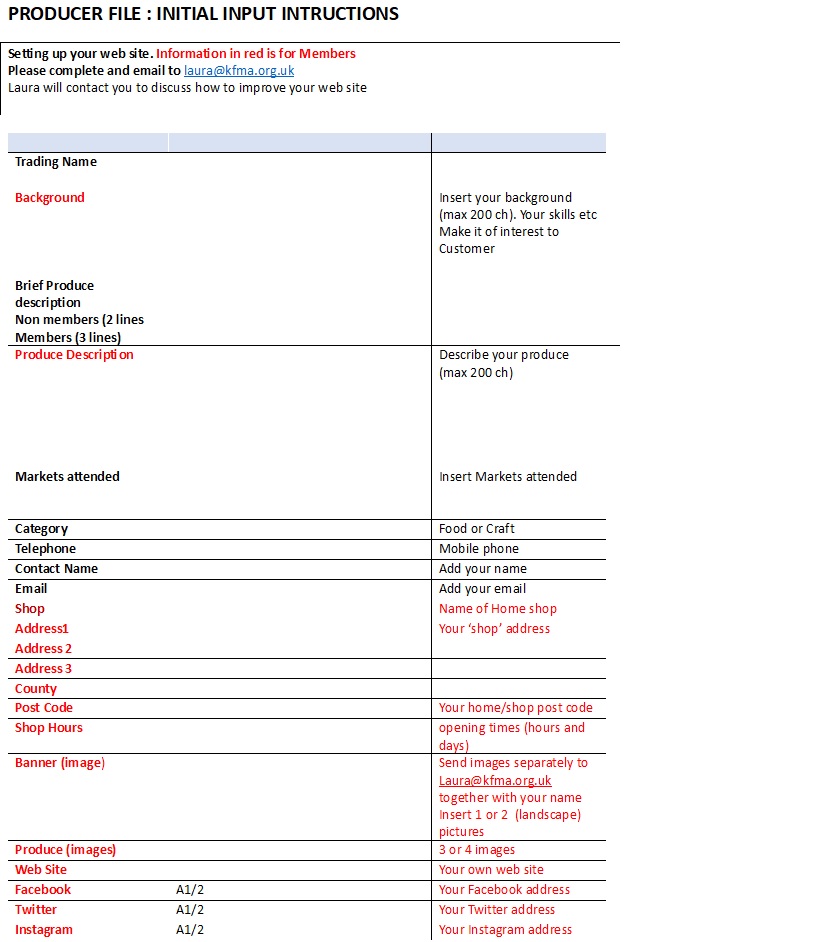
then email to Laura@kfma.org.uk.
She will then be in touch to complete your web site and organise payment
When an EHO visits your premises, they will be checking that you are complying with food laws and producing food that is safe to consume. To ensure this, they will check:-
One of the most important things that a health inspector will be scrutinising is the level of cleanliness both inside and outside your business. As they can arrive unannounced, at any time, you must always be on top of your cleaning schedule.
Outside doors, walls, and windows should be cleaned regularly, as should inside cupboards, fridges, ovens, corners, and the bottoms of tables. Note that clutter tends to make places look dirtier than they actually are, so make sure everything is stored neatly and in its own space.
EHO professionals look beyond aesthetic cleanliness – broken power sockets, sharp edges, or faulty appliances can all pose as a danger to your customers. For this reason, you should make sure that all the equipment and furniture in your premises is in full working order, and stored out of the way of the public and employees when not in use.
Even if you have excellent hygiene standards and great working conditions, you can still be penalised over insufficient facilities. Access to hot water is crucial for maintaining good hygiene practices, so make sure all hot taps are accessible and functional. Ventilation, drainage, and lighting may also be inspected, so try to check that all lightbulbs are working, at least once a week.
During an EHO inspection, you will be asked to provide a copy of your HACCP compliance documentation (See Appendix B), so make sure you have a copy that is complete, accessible, and well-maintained on your premises.
These documents are essential proof for the EHO that your business is observing all safety protocols and that all critical points are monitored. It’s worth checking through your documentation and filling out any gaps ASAP.
Your EHO may ask to observe safety checks being carried out or to access evidence of staff training procedures. For this reason, you must make sure that you fully comply with all HACCP guidance and food safety training protocols. If you are unsure as to what needs to be followed, click here to check the FSA guidelines on HACCP.
When an EHO visits, they will pay special attention to any areas used to prepare or store food. These areas are classed as ‘critical hygiene’ areas.
When cleaning, these areas must be dealt with thoroughly. Textured surfaces can create tiny pockets where bacteria thrive, so make sure that these areas are disinfected regularly.
Note that officers will pay interest in how food is transported back and forth from your business. Therefore, any vehicles used to transport food must be clean and accessible for inspection purposes.
Bins are breeding grounds for bacteria, so waste disposal must be managed effectively and considered carefully. Waste storage must be kept at a safe distance away from food preparation areas, and all bins must be thoroughly cleared and cleaned at least once a day.
No bins should be left with food inside overnight, and pest control measures must be implemented in food waste storage areas. EHO officers are always vigilant towards any signs of infestation.
After the inspection has taken place and all relevant data has been analysed, the Environmental Health Authority (EHA) publishes a report. The report will list all the good and bad things identified during the inspection.
There will be ample praise for the good things that your business is doing to ensure good health and hygiene standards. For any bad practice, faults will be explained, and improvement advice will be outlined. There will also be a timeframe provided as to when any improvements should be completed. These timeframes will reflect the number of faults identified and how easy they will be to rectify.
Food Hygiene is critical to selling your food produce at farmers markets. It affects all food but mainly the preparation of produce you make. HACCP (Hazard Analysis and Critical Control Point has been developed as a food safety management system by the Food Standards Agency and their guide 'MyHACCP' is a free web tool that will guide you through the process of developing a food safety management system. We recommend you sign up for this.
The 'MyHACCP' Tool will be able to produce a food safety management system that shows how your business identifies and controls any hazards that may occur in the food you make. You will find a range of resources to assist you with completing the tool and with understanding implementation of HACCP principles more generally in the Help section.

A Food Hygiene Rating of 0 means that urgent improvement is necessary.
A Food Hygiene Rating of 1 means that major improvements are necessary.
A Food Hygiene Rating of 2 means that improvements are necessary.
A Food Hygiene Rating of 3 means that the business was found to be generally satisfactory.
A Food Hygiene Rating of 4 means that the business was rated as good on assessment.
A Food Hygiene Rating of 5 means that the business was seen as very good.
This chart defines allergies which should be noted on your food labels 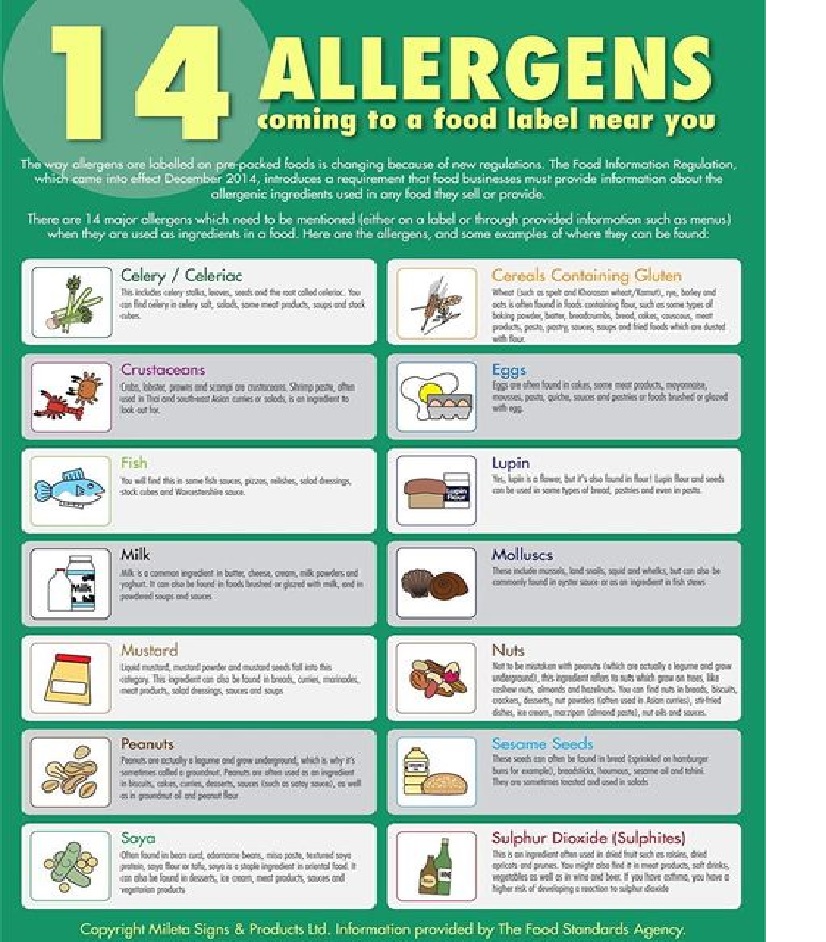
Allergy advice is VERY IMPORTANT as you need to warn customers about allergies in your products which could harm them. You will need create and show your customers an Allergen Chart which includes all your products.
A word document is also available Please request from Laura@kfma.org.uk
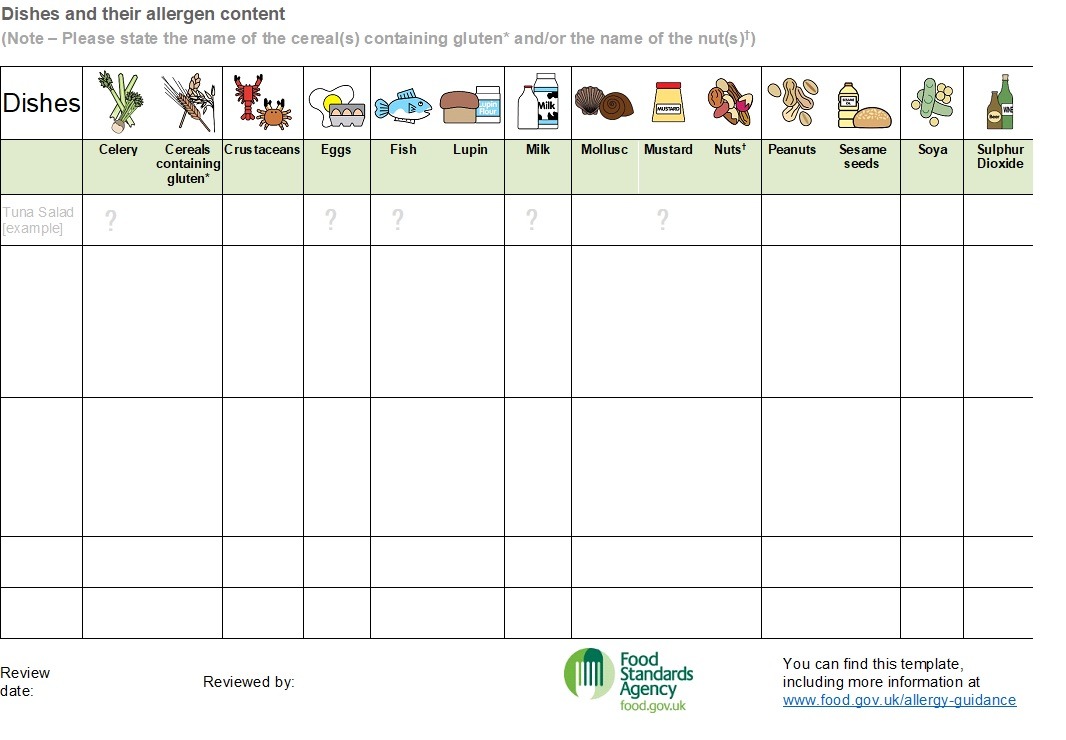
The purpose of this policy is to:-
The Policy lays out the commitments made by the market and informs staff, associated personnel and Stallholders/Producers (*) of their responsibilities in relation to safeguarding.
Sexual harassment in the workplace Anti Bullying and Harassment Policy
• Safeguarding concerns in the wider community
The Market believes that everyone we come into contact with, regardless of age, gender identity, disability, sexual orientation or ethnic origin has the right to be protected from all forms of harm, abuse, neglect and exploitation. The Market will not tolerate abuse and exploitation by staff or associated personnel.
This policy will address the following areas of safeguarding: child safeguarding, adult safeguarding, and protection from sexual exploitation and abuse. It also concerns the Code of Conduct expected of Stallholders when present at the market
The Market commits to addressing safeguarding throughout its work, through the three pillars of :
Market personnel and associated personnel must not:
Market personnel and associated personnel must not:
Market personnel and associated personnel must not:
Additionally, Market personnel and associated personnel are obliged to:
I,4,3 The Market will also accept complaints from external sources such as members of the public, partners and official bodies.
Market personnel and associated personnel who have a complaint or concern relating to either Safeguarding or Code of Conduct should report it immediately to the Market Manager.
The Market Manager will keep a formal report of all complaints or concerns and responses
The Market Manager will :-
It is essential that confidentiality in maintained at all stages of the process when dealing with both breakages of Code of Conduct and Safeguarding concerns. Information relating to the concern and subsequent case management should be shared on a need to know basis only, and should be kept secure at all times.
Someone who directly receives goods or services from Market’s programme. Note that misuse of power can also apply to the wider community that the Market serves and also can include exploitation by giving the perception of being in a position of power.
A person below the age of 18
Psychological, physical and any other infringement of an individual’s rights.
I 8.4 Psychological harm emotional or psychological abuse,
This includes (but is not limited to) humiliating and degrading treatment such as bad name calling, constant criticism, belittling, persistent shaming, solitary confinement and isolation
• Food Labelling/Food Information to consumers. https://www.food.gov.uk/business-guidance/packaging-and-labelling
• General Food Law https://www.food.gov.uk/business-guidance/general-food-law
• QUID Labelling https://www.businesscompanion.info/en/quick-guides/food-and-drink/labelling-of-prepacked-foods-QUID
• Health and Nutrition Claims. https://www.gov.uk/government/publications/nutrition-and-health-claims-guidance-to-compliance-with-regulation-ec-1924-2006-on-nutrition-and-health-claims-made-on-foods
• Weights and Measures packaged goods. https://www.gov.uk/guidance/packaged-goods-weights-and-measures-regulations
• Scales in use for trade: https://www.businesscompanion.info/en/quick-guides/weights-and-measures/weighing-equipment-for-legal-use
• Distance sales. https://www.food.gov.uk/business-guidance/distance-selling-mail-order-and-delivery
• Protected Foods. https://www.gov.uk/guidance/protect-a-geographical-food-or-drink-name-in-the-uk
• Organic Products. https://www.businesscompanion.info/en/quick-guides/food-and-drink/labellling-and-describing-organic-food
• Pricing. https://www.businesscompanion.info/en/quick-guides/pricing-and-payment
• Allergens. https://www.food.gov.uk/business-guidance/labelling-guidance-for-prepacked-for-direct-sale-ppds-food-products
If you have any queries on your legal obligations or are having difficulties complying with farming regulations, please do not hesitate to contact Trading Standards. We will do all that we can to help.
Click here for Government advice re setting up a Business. And Click here for information on working for yourself
Add a formal package to your grant request (or adding a list or procedures) as it creates a more professional and serious approach. Th e package comprises the formal items which need to considered and reviewed when running a market. By incorporating them in a 'package' to give to your Local Government and other sponsors, together with a budget, you will at least be placed higher in the 'queue'. These procedures are:-
This is an essential document as it shows you have spent time in determining costs and income and developing your budget
This is a new fund aimed at offering 50% refund on CAPITAL PROJECTS for small food retail businesses based in rural areas. The next round commences April 2024
This is a Government initiative to support small local rural businesses. Local Authorities (L.A) were requested to bid to administer the fund. In Kent the following Local Authorities were successful. Unfortunately each LA administers the grants in their own way so apart from the objectives the timings and requirements may well differ from LA to LA.
The fund is limited to CAPITAL items only and offers up to 50% of the total amount.
Although the fund is aimed at small food retail businesses Markets could also benefit (see potential list below)
We will be informing all Producers of the grant and would ask you to also inform them
The LA areas covered by the grant are:-
You will have to approach the person in each area responsible for administering and supporting the grant (normally in the Economic Re-generation Manager).
The sorts of projects Markets could apply for are:-
Others more complex include:-
This is a flier developed by West Kent which describes general objectives :-purchasing new process and packaging machinery such as brewing equipment and onsite vending machines
Their website includes a webpage provides a good overview of potential grants see https://www.kentandmedwaygrowthhub.org.uk/learn-about-grants-and-finance/
This may also flags up other useful information
Good photos can make or break your web page. This section gives you ideas as to how you can o improve your photos)
Click here to see Cindy Ducek's tips on taking pictures
Disclaimer
Any information provided by Kent Farmers Market Association is for general guidance on rights and responsibilities and Is not legal advice. If you need more details on your rights or legal advice about what action to take, please contact either KCC Trading Standards, who can provide legal compliance advice, or a knowledgeable advisor or solicitor.
We are reliant on changes to operational information being received in a timely manner. In addition, weather conditions and seasonality may impact availability of produce and stallholder attendance at markets, and so we cannot guarantee the accuracy of all information.
Copyright notice
All photos, graphics and other information on this website is copyright © by Kent Farmers Market Association or the respective photographers or acknowledged authors. All rights reserved. Use of our material is only permitted as long as it is for support of Farmers Markets in Kent. Commercial use or any use for the purpose of publication elsewhere, and by whichever media, requires written permission from the Association, who can be contacted through info@kfma.org.uk.
| Target |

